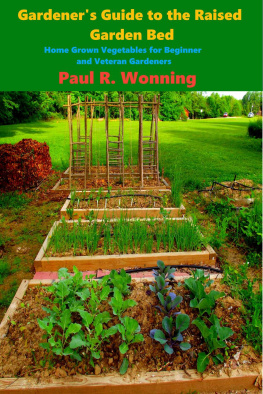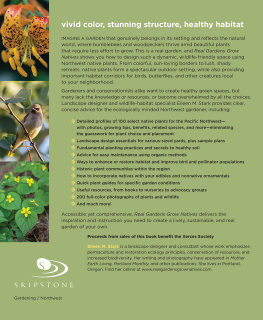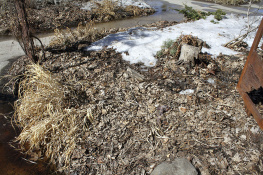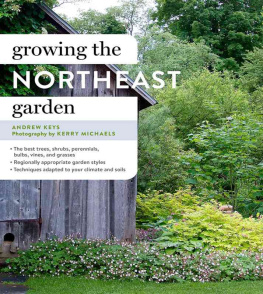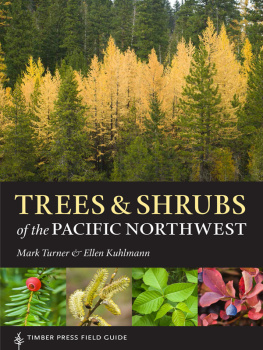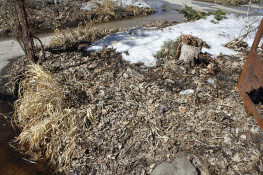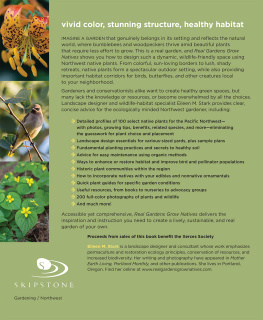
A Japanese maple takes on orange tones behind an exquisite evergreen wheel tree (Trochodendron aralioides) at the Gossler Farms Nursery display garden in Springfield, Oregon.
GARDENING
IN THE
PACIFIC
NORTHWEST
THE
COMPLETE
Homeowners
GUIDE
PAUL BONINE AND AMY CAMPION
Timber Press
Portland, Oregon


Contents

Gardens that live in harmony with their surroundings possess an easy elegance and require few inputs from the gardener.
INTRODUCTION

Pacific Northwesterners are passionate gardenersperhaps because we live in a land of unlimited planting possibilities. Our spectacular natural landscape and benign climate beckon us outdoors to cultivate and create. For the purposes of this guide, the Pacific Northwest includes the geographical regions of Oregon, Washington, and southwest British Columbia, on both sides of the Cascade Mountains. West of the Cascades, moderate temperatures allow us to succeed with a vast array of plants from all over the world. East of the mountains, a more arid continental climate produces larger swings in temperature, but this area offers no less interesting gardening.
THIS BOOK IS A GUIDE to creating vibrant gardens in the Pacific Northwest while also promoting balance and a more responsible use of resources. No other endeavor connects us so closely to the earth, the change of seasons, the weather. We can paint pictures, enrich the earth and air, provide important habitat for wildlife, grow food, act as conservator, and leave a legacy for future generations. Above all, we can expand our understanding of what a meaningful, personal outdoor space can be in this remarkable part of the planet.
To those ends, this book starts with an exploration of the weather conditions with which smart Northwest gardeners seek to form a cautious alliance. By working with nature instead of expecting the climate to suit our needs, we vastly increase our chances of gardening triumphs and decrease our incidents of frustration. Well cover the eight basic subregions in this part of the country and discuss how climate impacts gardeners in each area.
Next, well offer a guide to good garden culture, which begins with knowing what type of soil you have and how to work with it. Well give a lesson on planting in our wet-winter/dry-summer climate, and then well explain how to properly fertilize, irrigate, and mulch your Pacific Northwest garden. Well also discuss how to deal with diseases such as verticillium wilt and pests like azalea lace bug and slugs.
A significant portion of this book is comprised of portraits of carefully chosen perennials, shrubs, vines, and trees. Were convinced that gardening for diversity is vitally important. Around the world, the extinction rate of species is accelerating, and its imperative that our gardens help slow this trend by becoming zones of conservation and variety. We provide a comprehensive list of region-appropriate plants in an effort to help you keep your own gardens flora wonderfully eclectic.

We are blessed with a rich assortment of plants that thrive in Pacific Northwest gardens.
Finally, well illustrate the most popular garden styles of our region. Well show you gardens that have been designed to both embrace beauty and to fit into the landscape without taking a toll on the environment. Seeing how these retreats are in harmony with their surroundings paints a portrait of what is possible here.
Although this book has two authors, the story will be told from Pauls point of view, drawing on his more than 25 years of experience as a nurseryman in the Pacific Northwest. While Amys no stranger to the nursery industry herself, she is a relative newcomer to the area, and we felt it made sense to have Paul relay the story. Amys influence is found in the photos throughout the book and in the editing work shes done behind the scenes.
Whether youre a recent transplant or a lifelong Northwest resident, a newbie gardener or a seasoned veteran, there are lessons to be learned and great joys to be found in cultivating a little piece of paradise here. Our aim is to show you some of the many ways in which the pleasure of gardening can find expression in our corner of the world, as well as to share the principles that will help you succeed. We hope youll find enlightenment, guidance, and inspiration in these pages.

For eight or nine months of the year, rain falls regularly west of the Cascades, courtesy of the jet stream bringing moisture from the Pacific.
KNOW YOUR CLIMATE
ONE OF THE MOST BASIC ASPECTS of gardening is an understanding of the impacting forces above ground: weather and climate. (Climate is the measure of weather over time.) Mountains, valleys, bodies of water, and landmasses affect our regions weather in profound and complex ways. As a result, weather patterns can differ greatly from region to region, even between areas that are in close proximity to each other. Gardeners are wise to learn how these factors shape local climate in order to choose the plants and practices best suited to likely conditions.
SUBCLIMATES OF THE PACIFIC NORTHWEST
Here in the Pacific Northwest, weather predominantly moves from west to east, courtesy of the jet stream. From autumn through spring, the jet stream ushers warm, moist sea air inland. During the winter months, this climatic fire hose points directly at the Pacific Northwest, bringing storm after storm to our region. West of the Cascade Range, this regimen produces wet conditions, with rain turning to snow in the higher elevations. East of the mountains, less precipitation falls; away from the modifying influence of the ocean, larger fluxes in temperature occur, too.
In summer, the jet stream weakens and is deflected to the north by a ridge of high pressure. This annual intrusion of high pressure creates a dry season throughout most of the Northwest from June to September. Summer temperatures are typically mild, but occasionally high pressure spins clockwise, and air flows over and down the mountains, drying and heating the landscape as it goes. In western Washington, high temperatures during this offshore pattern reach the 80s and low 90s, the Willamette Valley may hit the 90s to low 100s, and in southwestern Oregon, stretches in the low 100s are not uncommon. These periods call for careful attention to irrigation. Even when cooler temperatures occur west of the Cascades in summer, they are often not accompanied by rainresulting in a net loss of moisture from the landscape.
Next page

